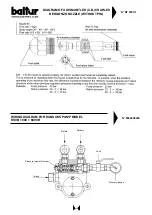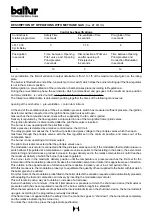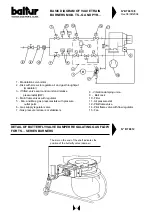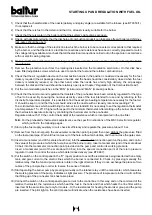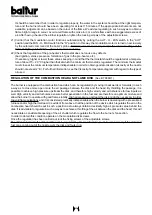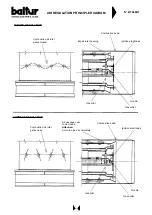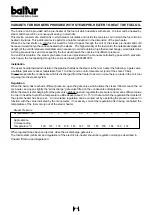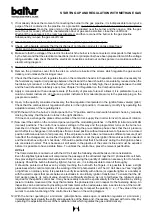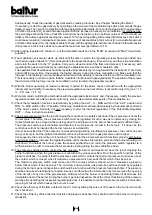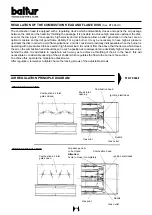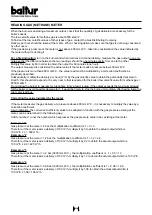
11
During the fuel oil pre-heating phase, voltage passes through the MS 30 electronic regulation thermostat of the pre-
heater and reaches the relay coil of the resistances. The relay closes and takes current to the resistances which, in
turn, heat the fuel contained in the pre-heater. By operating panel switch ( I ), the resistances which heat the pump
and the atomizer group are also inserted (only for version ...D).
The minimum thermostat of the pre-heater closes when the temperature reaches the value at which it has been set.
The control box will be connected only when the temperature in the pre-heater reaches the value at which it has been
set and causes the resistances to be disinserted (an opening of the contact of the regulation thermostat); therefore,
the fuel oil in the pre-heater should be at maximum temperature. The control box (cyclic relay) of the burner is
therefore connected by the regulation of the pre-heater when it excludes the resistances by disinserting the relative
relay.
Control Box Specifications
The cyclic relay control box carries out the ignition programme by starting up the fan motor in order to effect the pre-
ventilation phase.
If the air pressure supplied by the fan is sufficient to cause the intervention of the relative pressure switch, the pump
motor will be turned on immediately and will carry out a pre-circulation of hot oil in the burner pipes.
Oil from the pump reaches the pre-heater, is heated to the correct temperature and when it comes out it passes
through a filter before reaching the atomizer unit.
The hot oil circulates in the atomizer unit without coming out of the nozzle because the passages leading to the
outward and return nozzles are closed.
This closure is carried out by “closing pins” applied to the ends of the rods.
These “pins” are pressed against their seats by strong springs which are situated at the opposite ends of the rods.
The oil circulates, comes out of the atomizer group return, goes through the sump where the “TRU” thermostat is
inserted (only for ...D version) and arrives at the return pressure regulator; it passes through this and reaches the
pump return and from there is discharged into the return.
Hot oil circulation, as described above, is carried out at a pressure value slightly higher (some bar) than the minimum
pressure at which the return pressure regulator has been set (10 ÷ 12 bar).
This time can be extended (theoretically indefinitely) because a special device in the electric circuit does not allow the
ignition programme to be carried out until the temperature of the fuel in the nozzle return pipeline has reached the
temperature at which the “TRU” thermostat (thermostat on the nozzle return) has been set.
This special device does not allow the fuel to pass through the nozzle until it has reached at least the temperature at
which the “TRU” thermostat has been set. Normally, intervention of the “TRU” thermostat takes place within the pre-
ventilation time; if it doesn’t, pre-ventilation and fuel oil pre-circulation are extended until the intervention of the “TRU”
thermostat. The intervention of the “TRU” thermostat (oil in circulation sufficiently hot) allows the control box to
proceed with carrying out the ignition programme by inserting the ignition transformer which in turn feeds the electrodes
with high voltage. High voltage between the electrodes primes the electric spark for ignition of the fuel/air mixture.
6 seconds after the ignition spark appears, the control box carries voltage to the magnet which, by means of appropriate
levers, moves backwards the two rods which intercept the flow (outward and moves backwards the two rods which
intercept the flow (outward and return) of fuel to the nozzle. This moving backwards of the rods also determines a
closing of the passage (by-pass) inside the atomizer unit. Consequently, the pump pressure is taken to the normal
value of about 20 ÷ 22 bar. Deviation of the two rods from the closing seat, now permits the fuel to enter the nozzle at
the pressure at which the pump has been regulated at (20 ÷ 22 bar), and comes out of the nozzle adequately
atomized. The return pressure, which determines delivery to the furnace, is regulated by the return pressure regulator.
The value of the ignition flow rate (minimum delivery) should be about 10 ÷ 12 bar).
The atomized fuel which comes out of the nozzle is mixed with air supplied by the fan and is then ignited by the spark
of the electrodes. Flame presence is detected by the UV Photocell.
The programme proceeds and surpasses the “shut down” position, disconnects the ignition transformer, and then
connects the modulation circuit. The modulation servomotor commands an increase in the delivery of fuel and
combustion air at the same time. The increase in fuel delivery is determined by a disk with a varied profile which, by
rotating, can determine a greater compression of the return pressure regulator spring and thus an increase in the
pressure itself. When the return pressure increases, there is also a corresponding increase in fuel delivery.
DESCRIPTION OF OPERATIONS WITH FUEL OIL
(See drawing 0002901000 and BT 8867)
Control box
& relative
Programmer
LFL 1.333
Cyclic Relay
Safety Time
in seconds
3
Pre-Ventilation & Oil
Pre-Circulation Time
in seconds
31,5
Pre-Ignition
Time
in seconds
6
Post-Ignition
Time
in seconds
3
Time Between
1st Flame &
Start of Modulation
in seconds
12
Summary of Contents for TS 0 GN
Page 2: ......
Page 47: ......
Page 48: ......
Page 49: ......
Page 50: ......
Page 51: ......
Page 52: ......
Page 53: ......
Page 54: ......
Page 55: ......
Page 56: ......
Page 57: ......
Page 58: ......
Page 59: ......
Page 60: ......
Page 61: ......
Page 62: ......
Page 63: ......
Page 64: ......
Page 65: ......
Page 66: ......
Page 67: ......
Page 68: ......
Page 69: ......
Page 70: ......
Page 71: ......
Page 72: ......
Page 73: ......
Page 74: ......
Page 75: ......
Page 76: ......
Page 77: ......
Page 78: ......
Page 79: ......
Page 80: ......
Page 81: ......
Page 82: ......
Page 83: ......
Page 84: ......
Page 85: ......
Page 86: ......
Page 87: ......
Page 88: ......
Page 89: ......
Page 90: ......
Page 91: ......
Page 92: ......
Page 93: ......
Page 94: ......
Page 95: ......

















